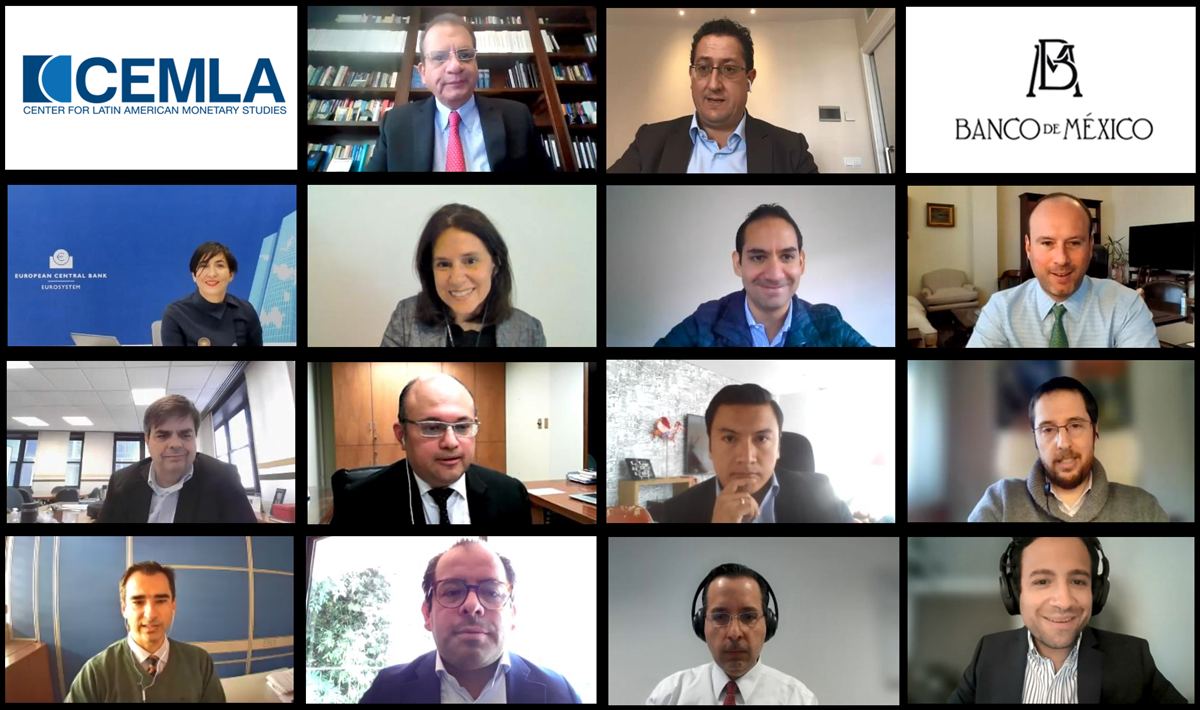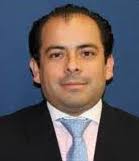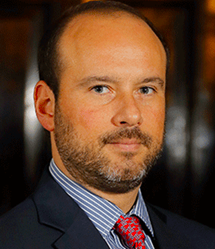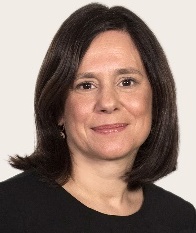
XI Central Banking Operations (Digital) Meeting
CEMLA and Banco de México
June 30 – July 2, 2021
Videoconference
The XI Central Banking Operations Meeting was held in digital format from June 30 to July 2, 2021. It was jointly organized by the Center for Latin American Monetary Studies (CEMLA) and Banco de México. This meeting was aimed at central banking operations officials and researchers from members of CEMLA. Its general purpose was to exchange recent experiences on thematic issues related to the rationale, mechanisms, and evaluation of central banking operations in response to the COVID-19 crisis.
Manuel Ramos-Francia, CEMLA's General Director, delivered the opening remarks. He focused on the main central banking operations' challenges derived from the COVID-19 pandemic. At the outset of the crisis, the immediate objectives of central banks were in general the provision of liquidity and enabling the flow of credit in the economy. Presently, they are facing an uncertain and heterogenous economic recovery. He underscored three issues that should be taken into consideration when adjusting the monetary policy stance in the present context. First, growth potential might have been adversely affected, which can affect the sustainable rate of aggregate demand expansion. Second, determining the phase of a business cycle with precision is challenging, given that it has not followed its usual dynamics, as there has been demand compression. Finally, disruptions in the labor market must be taken into account. He concluded by mentioning that it is key "[…] to maintain a sufficient and timely supply of liquidity, accompanied by efficient communication to guide the markets in a coherent manner so that monetary policy can be effective".
Óscar Arce, Director General of Economics, Statistics and Research, at Banco de España, presented an overview of the monetary policy responses of advanced and emerging market economies to the COVID-19 pandemic. He stressed out the importance of the agility of central banks' decision-making. He explained the monetary policy measures implemented more recently. Such measures have included asset purchase programs, financing facilities, and the relaxation of capital requirements, among others. During the economic recovery, heterogeneity across economies is expected, which may become a challenge to emerging market economies (EMEs). This would be particularly the case if there is an acceleration in monetary policy normalization on the part of advanced economies (AEs). For EMEs, latent risks and vulnerabilities relate to fiscal deficits. The evolution of the public health crisis itself and the performance of vaccination programs will play key roles in the recovery.
The second session of the Central Bank Operations Meeting focused on the policy responses of advanced economies. It featured Imène Rahmouni-Rousseau, Director General for Market Operations in the European Central Bank and Lorie K. Logan, Executive Vice President of the Markets Group at the Federal Reserve Bank of New York, manager of the System Open Market Operations (SOMA) for the Federal Open Markets Committee (FOMA) and Head of Market Operations, Monitoring and Analysis (MOMA). Ms. Rahmouni-Rousseau explained that the European Central Bank (ECB) responded with the full spectrum of its monetary policy instruments and banking supervision measures to face the challenges derived from the COVID-19 pandemic. The ECB policy response has had the following objectives: the provision of credit and the injection of liquidity, the improvement of financial conditions, and to avoid markets' fragmentation. It included measures such as longer-term refinancing operations, collateral easing, swap operations, repurchase agreements for the provision of foreign currency liquidity, and asset purchases, and the pandemic emergency purchase program (PEPP). She explained the implementation of the first fiscal response at a euro zone level. She also highlighted that it is crucial to maintain flexibility and recalibrate policy if and when new market information warrants it. Finally, it is important to maintain adequate fiscal support and to consider the strong interaction and complementarity of fiscal and monetary policy.
Lorie K. Logan spoke about the main aspects of the Federal Reserve's policy response, the transition to more normal operations, the potential of two new permanent tools, and its policy implementation framework. Ms. Logan highlighted the Fed's integrated policy response to support smooth market functioning and to ensure the flow of credit. In this context, the Fed conducted repo, asset purchase operations, expanded access to credit and ensured liquidity. The smooth functioning of these policy actions has allowed the transition to the normalization of operations. Asset purchases are being conducted at a steady pace to foster accommodative financial conditions. Furthermore, markets have reacted well and indicators have shown favorable outcomes.
The third session of the Meeting included a presentation on Changing Patterns of Capital Flows, a report presented by the Committee on the Global Financial System, co-edited by Gerardo García López, General Director of Central Banking Operations of Banco de México, and Livio Stracca, the Deputy Director General of International and European Relations at the ECB. It was presented by the former. The report describes some of the key changes in capital flows patterns. It also considers their key macroeconomic and financial stability implications. It shows trends of capital flows, their determinants, the risks and benefits of capital flows, and policy tools to address their associated challenges.
For his part, Manuel Ramos-Francia, presented a study, on the determinants of bond flows, using data from Brazil, Chile, Colombia, Mexico, and Peru. He explained the effects of changes in global factors, measured by the VIX index, local factors, captured by term premium spreads, and pipes factors, as measured by changes in international reserves, the proportion of local currency-denominated bonds held by non-resident investors, and EMEs bonds trading volume, on the mean, variance, skewness, kurtosis of bond flows' densities, and on bonds-flows-at-risk. He underscored the relevance of the global factor for the left tail of the density. In addition, he argued that pipes factors play a key role in the determination of the variance of the bond flows density. Dr. Ramos-Francia concluded his talk by reiterating the importance of liquidity provision and good structural policy to manage the risks associated with bond flows.
In the fourth and fifth sessions, central banks' top-level officials from Mexico, Chile, Brazil, Peru, Colombia, Argentina, and Uruguay presented the policy measures put in place to deal with the COVID-19 crisis, some of the results of the interventions, and macroeconomic projections. The official described the major challenges in the normalization of central bank operations and pointed out some of the lessons learned.
Gerardo García López explained that Banco de México has had a multidimensional policy response to the crisis made of four pillars: (i) monetary policy, through the reduction of the target rate from 7% to 4%; (ii) liquidity provision, through a decrease in monetary regulation deposits, operation with excess intra-day liquidity, the establishment of extraordinary liquidity facilities, and securities lending facilities; (iii) opening long-term credit channels; and (iv) ensuring an orderly market dynamics, providing foreign currency liquidity using the Federal Reserve Swap Lines, and government bond exchange operations. The impact of these measures has been favorable. In this context, the use of the extraordinary facilities has gradually decreased and is planned to be ended in September 2021. Banco de México's post-COVID-19 agenda will focus on the development of financial markets; in particular, derivatives, real interest rate debt, and corporate debt markets. This has the aim of fostering an increase in the local and foreign investor base. Banco de México is preparing for the phase-out of LIBOR rates, as these interest rates are likely to cease to exist by 2023.
Diego Gianelli, Manager of the Financial Markets Division (a.i.) of Banco Central de Chile, explained that since the social outbreak of 2019 and especially after the COVID-19 crisis, the Central Bank of Chile has implemented extraordinary and unprecedented measures that have helped mitigate the economic and financial effects. The associated measures included interest rate reductions and asset purchase programs. They have reduced financing costs, helped sustain credit, and provided liquidity. Such measures supported a recovery in economic activity. They have had an important impact on Banco de Chile's balance sheet: the monetary base doubled and the volume of operations quadrupled, which has led to an increase in its risk profile. As aggregate demand has recovered, supported by the fiscal stimulus and pension fund withdrawals, the extraordinary monetary measures will eventually start to be normalized. He explained that the timing, pace, and coherence of the normalization of operations are key.
André Amante, Head of the Open Market Operations Department of the Banco Central do Brasil, explained the main monetary policies that the Brazilian Central Bank implemented to provide liquidity to the markets and maintain the flow of credit in response to the COVID-19 crisis. These included the reduction of reserve requirements and facilities for the provision of liquidity, among others. Monetary policy measures were effective in providing better conditions for market functioning. The year-over-year inflation rate reached 8.1% in April 2021. Despite this, economic activity has performed well, particularly the manufacturing and commercial sectors have recovered to pre-pandemic levels. The confidence outlook has also recovered, and the Brazilian economy is expected to grow at 5.1 % in 2021. On the other hand, the monetary policy interest rate has been increased, and is expected that this will continue through the end of the year. Banco Central do Brasil expects to begin the transition to the normalization of its operations in the near term.
Paul Castillo Bardalez, Head of Monetary Operations and Financial Stability Management of the Banco Central de Reserva del Perú, presented the policy responses implemented by the referred central bank, as well as the recovery scenario, and the possible challenges that the Peruvian economy could face. In order to inject liquidity, stabilize financial markets, and maintain the flow of credit and the functioning of the payments market, the central bank reduced its monetary policy rate to a historic low and implemented a series of unconventional monetary policies. The intervention reached most financial institutions and led to an increase in corporate credit of almost 20%. He noted that operational flexibility, innovation, and inter-institutional collaboration have been crucial to achieve these results. Given the recovery, he stated that the current monetary policy stance is expected to be maintained until the end of the year. An economic growth rate of close to 11% is expected in 2021. Credit has continued to expand and inflation has remained within the target range. Going forward, Peru faces significant challenges, including the effective use of its monetary policy to mitigate volatility in financial markets and provide foreign currency liquidity to contain FX pressures. This involves using targeted strategies to provide liquidity to small financial institutions, mutual and pension funds.
Regarding the measures implemented by Banco de la República (Colombia) and how markets have responded, Juan Sebastián Rojas, Director of the Open Market Operations and Market Analysis Department, summarized the measures implemented to counteract the effects of the crisis. First, the central bank has had, in this context, as its main objectives: 1) to have a rapid response to normalize economic conditions; 2) to generate the incentives to activate the credit market and improve the confidence of the different economic agents; 3) to ensure liquidity and allow it to flow to the different participants in the economy; 4) to support growth and economic activity; and, 5) to provide support for the proper functioning of markets. The central bank focused on these objectives through three strategies: first, providing liquidity in local and foreign currency, through the increase of repo operations, expansion of eligible collaterals, the purchase of private debt securities, and FX market interventions; second, ensuring that markets were functioning properly, through private and public debt securities purchases; and, the support of the economic recovery, via reductions in the monetary policy rate, a decrease on the reserve requirements, and changes in repo operations associated with public debt. Mr. Rojas explained that a series of policies were implemented to mitigate counterparty, liquidity, market, credit, and operational risks. The outlook for economic growth and inflation expectations have shown improvements. Mr. Rojas concluded by speaking on the downgrade of Colombia's credit rating.
Germán David Feldman, Economic Research Deputy General Manager at Banco Central de la República Argentina (BCRA), presented the policy response in the context of the COVID-19 crisis, the evolution and adjustment process of economic recovery, as well as Argentinian upcoming short- and medium-term challenges. Argentina had dealt with two years of macroeconomic instability, inflation levels above 50%, and two years of recession. Consequently, at the time of the COVID-19 shock, Argentina faced a reduced policy space. The BCRA's monetary policy response entailed a significant reduction in its policy interest rates, lower reserve requirements on bank lending to SMEs and independent workers, temporal easing of bank provisioning needs and banks' loan classification-rules, and the refinancing of unpaid credit cards The measures have achieved a progressive recovery of economic activity, although it remains below pre-pandemic levels. Feldman concluded stating that the main challenges for the Argentine economy include progressively easing capital controls, the consolidation of a gradual disinflation process, reducing the central bank's liabilities in terms of GDP, the promotion of economic growth, the reduction of financial dollarization, and the development of domestic capital markets.
Pablo Costa, Head of the Monetary Operations Department of Banco Central del Uruguay commented upon two key aspects: the change of instruments and the policy response in the pandemic. On the first matter, he indicated that upon the entry of the new board of the Central Bank of Uruguay two objectives were set: to return to interest rates as an instrument of monetary policy—which was achieved in September 2020 with a rate of 4.5%—, and to begin a policy of de-dollarization of the financial and commercial economy—in this regard, actions have been taken to establish reserve requirements differences in domestic and foreign currencies to incentivize the de-dollarization. At the time of the COVID-19 economic shock, the board reacted immediately by lowering reserve requirements to increase credit granting and prolonged payments on financial loan obligations with the main objective of ensuring liquidity. In terms of the short- and medium-term effects on economic performance, Uruguay's GDP suffered a 5.9% drop, which, in addition to the pandemic, was affected by strong droughts during the summer. Private consumption, net exports, and employment fell drastically, although investment showed great progress. On the inflation side, a slight increase was seen in the face of a transitory shock in fuel prices and the depreciation of the exchange rate, however, it stabilized and returned to the target range. The performance of the economy in the first quarter of 2021 was deteriorated due to the lack of tourism, though the outlook has improved as a result of a more aggressive vaccination strategy. Regarding the monetary policy outlook, a gradual increase in the interest rate is expected and medium-term inflation expectations remain outside the range.
The XI Central Banking Operations Meeting concluded with a round table discussion reflecting on the measures taken in the wake of the COVID-19 pandemic, as well as the challenges that have persisted. The discussion mostly focused on the following topics. First, each country's experience with unconventional monetary policies. Second, the instruments used in this period, the compliance problems with the facilities deployed, and the possible presence of moral hazard. Third, concerns with the U.S. expected inflation path and the relevance of the timing and sequencing of the monetary stimulus withdrawal.
June 30, 2021
Opening Remarks
Manuel Ramos-Francia, Director General, CEMLA
Session I. Invited Contribution
Monetary Policy and its Perspectives in Advanced Economies ![]()
Óscar Arce, Director General for Economics, Statistics and Research, Banco de España.
Session II. Central Bank Operations in AEs: Crossing the COVID-19 Bridge
Advanced Economies (AEs) have maintained a highly accommodative monetary policy stance, as they have faced similar conditions. More recently, however, their monetary policy prospects have started to differ. In particular, the U.S. inflation outlook for the foreseeable future seems to be diverging from those of the eurozone and Japan, as its economic activity gathers more strength, and supply disruptions are present given the pandemic. The eurozone’s inflation has recently increased, mostly due to transitory factors. However, it is expected to remain below target over the relevant horizon. For its part, Japan continues to face a complex situation, as inflation expectations are stuck at zero. What does this likely scenario mean for monetary policy and its operation in AEs in the next few quarters?
The Eurosystem response to COVID-19 ![]()
Imène Rahmouni-Rousseau, Director General of Market Operations, European Central Bank.
From Crisis to Recovery ![]()
Lorie K. Logan, Executive Vice President, Markets Group, Federal Reserve Bank of New York.
July 1, 2021
Session III. Special Talks
Changing Patterns of Capital Flows ![]()
(BIS-CGFS Paper prepared by a working group co-chaired by Livio Stracca (ECB) and) Gerardo García López, General Director of Central Banking Operations, Banco de México.
Bond Flows-at-Risk: Global Local, and Pipe Factors in Latin America ![]()
Manuel Ramos-Francia, General Director, CEMLA.
Session IV. Ongoing COVID-19 Central Bank Policies in EMEs: An Operations Perspective
Emerging market economies (EMEs) in the region have faced both challenging domestic and external conditions. On the domestic front, sectors have been affected differently by the pandemic. Thus, how should a central bank proceed when shutting down a facility? Should it differentiate among sectors in the process? How long should a central bank wait to end a facility once it has not been in use? There are benefits to waiting, as it signals that support will be available in case financial market conditions deteriorate. Even as central banks in the region have to make decisions concerning day-to-day issues such as the above ones, the overarching theme is the possible changing outlook for U.S. inflation. Particularly, in most cases in the region, a change in U.S. inflation would likely have important repercussions on domestic monetary policies. How these possible changes come about operationally would depend on the type of instruments the different central banks have deployed to increase the degree of monetary accommodation in the last few years, particularly, during the pandemic.
Central Bank Operations’ Most Recent Challenges: The Mexican case ![]()
Gerardo García López, General Director of Central Banking Operations, Banco de México.
Special Operations to Address Covid Financial Turmoil at the CBCh ![]()
Diego Gianelli, Director of the Financial Markets Division (a.i.), Banco Central de Chile.
On the BCB’s Monetary Operations ![]()
André Amante, Head of the Open Market Operations Department, Banco Central do Brasil.
July 2, 2021
Session V. Ongoing COVID-19 Central Bank Policies in EMEs: An Operations Perspective (continues)
Central Bank Operations and their Current Challenges in Peru ![]()
Paul Castillo Bardalez, Chief Officer for Monetary Operations and Financial Stability, Banco Central de Reserva del Perú.
Liquidity Measures and Market Responses in the Way to Recovery ![]()
Juan Sebastián Rojas, Director, Operations Department and Market Development, Banco de la República (Colombia).
Monetary Policy Readjustment After the COVID-19 Shock ![]()
Germán David Feldman, Economic Research Deputy General Manager, Banco Central de la República Argentina.
Monetary Policy in the Pandemic, from the Change of Instruments to the Normalization of the Economy ![]()
Pablo Costa, Chief, Monetary Operations Department, Banco Central del Uruguay.
Session VI. Policy Roundtable: Central Bank Operations’ Challenges and Outlook
The economic recovery in the region is uncertain and heterogenous. Vaccination programs are slowly moving forward, with some marked differences. Policy makers are, in general, seeing reduced fiscal space. Some could relatively soon face the decision of adjusting certain central bank’s programs and facilities. More importantly, beyond local challenges, there is the risk of inflation materializing in the U.S., which could put pressure on local nominal interest rates and, thus, have important policy implications. In this context, we think it is useful to conceive three possible scenarios. The first one involves an inflationary hump. This means that inflation will initially temporarily increase and the Federal Reserve would possibly accommodate it. The supply and labor market frictions would be sorted out, and there would be little or no stress in financial markets.
Under the second scenario, a considerable fiscal expansion in the U.S. would translate into a larger current account deficit, as it is hard to anticipate full Ricardian Equivalence, leading to a twin deficits type of situation. The excess absorption would translate into an increase in the current account deficit, with little repercussions on the exchange rate and only relatively moderate increases in interest rates, as the U.S. uses its exorbitant privilege. There would be no financing issues and only moderate pressures on prices, yields would likely rise somewhat further, although with no significant stress in bond markets, and the U.S. dollar would possibly appreciate.
Under the third scenario, aggregate demand would accelerate in such a way that it leads to an important increase in inflation. As adverse price and wage dynamics take hold, the Federal Reserve is forced to tighten rapidly its monetary stance. The fiscal expansion and the concomitant pressure on inflation and interest rates put considerable stress in financial markets. Financing of the deficit could become problematic, as demand for U.S. government bonds could drop significantly. In this case, the U.S dollar depreciates and Treasury yields would increase substantially. To some extent, such dynamics would mimic traditional BOPs’ crisis in EMEs. We believe this scenario to be highly unlikely.
What operational challenges would central banks face under each scenario? Perhaps the biggest issue pertains to whether central banks will try to maintain accommodative monetary stances or whether, contingent on domestic and/or global factors, they will have to reduce significantly the degree of monetary accommodation. In both cases, the choice and sequence of use of the different instruments would be key.
Policy Roundtable
Chair: Manuel Ramos-Francia, General Director, CEMLA.
Participants:
Juan García (Banco de México)
Diego Gianelli (Banco Central de Chile)
André Amante (Banco Central do Brasil)
Juan Sebastián Rojas (Banco de la República (Colombia)

André Amante
André Amante is the head of the Open Market Operations Department at Banco Central do Brasil. He is responsible for implementing the BCB's monetary operations, managing the central depository system for federal government securities, and providing assessments on monetary policy topics at the MPC meetings.
Previously, he worked as a senior advisor in the same department from 2001 to 2018 and as a researcher in the BCB's Research Department from 1999 to 2001. Mr. Amante holds a Master degree in Business Administration from the Coppead School of Business and a Bachelor of Science degree in Mechanical Engineering, both from the Federal University of Rio de Janeiro, Brazil.
 Óscar Arce
Óscar Arce
Óscar Arce is the Director General of Economics, Statistics and Research at Banco de España, where he also has served as Associate Director General of Economics and Research, Director of Monetary and Financial Studies and as the Head of the Macroeconomic Analysis and Forecasting Division. Previously, he was the Director of the Research and Statistics Department at the Spanish Securities Markets Commission (CNMV), Deputy Director General at the Economic Bureau of the Spanish Prime Minister and Senior Economist at the Banco de España.
Mr. Arce holds a PhD in Economics from the London School of Economics and Political Science and a MSc Economics from University College London. He is an alternate member of the European Central Bank's Governing Council, member of the ECB's Monetary Policy Committee, and member of the EU's Economic and Financial Committee. Before, he was involved in the work of several international bodies, including the European Securities and Markets Authority (ESMA), the European Systemic Risk Board (ESRB), and the International Organization of Securities Commissions (IOSCO).
 Paul Castillo
Paul Castillo
Paul Castillo has been in charge of the Monetary Operations and Financial Stability Management at Central Reserve Bank of Peru since March 2020. Previously, he served as Manager of Monetary Policy (November 2016 - March 2020), Deputy Manager of Monetary Policy Design (March 2008 - October 2016), Head of the Department of Policies of the Real Sector (September 2007 - February 2008), Research Specialist at the Economic Research Sub-management (December 2004 - August 2007), Analyst at the Financial Analysis and Programming Department (May - September 1998), and Analyst at the Non-Banking Financial Intermediation Department (May 1996 - December 1997). Paul Castillo joined the Bank in May 1996, after successfully completing the XLIII University Extension Course of the BCRP.
Mr. Castillo has a PhD in Economics from the London School of Economics and Political Science (2007), a Master's in Economics from the same university and he studied Economic Engineering at the National Engineering University. He has participated in various international courses and seminars organized by the IMF, as well as various courses and seminars held at the Pontificia Universidad Católica del Perú, the Peruvian-German Chamber and the National Exporters Association, among others.
Mr. Castillo is a professor of the Masters in Economics at the Universidad del Pacífico, a professor of the Economic Engineering Program at the National University of Engineering and of the Economics program of the Peruvian University of Applied Sciences (UPC).
He is the author of research and publications on areas in which he is a specialist: macroeconomics, monetary policy, and applied econometrics. His research has been presented at international conferences such as Computational Finance and Economics, LACEA, and various central banks.
 Pablo Costa
Pablo Costa
Pablo Costa is the Head of Monetary Operations Department at Central Bank of Uruguay (BCU) since 2015. He began working as an Analyst of the Fiscal Analysis Department in 2004 at this Institution. Then, he went on to serve as an Analyst in the Monetary Operations Department in 2008.
He holds a Licentiate in Economics from Universidad de la República and has an MBA with distinction on Finance from Universidad Ort Uruguay.
He has participated in various international courses and seminars organized by the IMF, CEMLA, World Bank, and FLAR, among others. He also taught a course for CEMLA in 2016 for officials of the Cuban Central Bank on financial markets development.
He is responsible for implementing BCU's Monetary Policy as well as the exchange rate market interventions. The Monetary Operations Department is in charge of the Government Bonds' auctions, in the BCU capacity as the financial agent of the Central Government.
 Germán David Feldman
Germán David Feldman
Germán David Feldman is the Economic Research Deputy General Manager at the Central Bank of Argentina.
He holds an undergraduate degree in Economics from Universidad de Buenos Aires and a master's degree in Economics from Universidad de San Andrés. He also holds a PhD in Economics from Johann Wolfgang Goethe-Universität.
Prior to his current position at the Central Bank of Argentina, he was a member of the Board at the BCRA (2013-2016) and Superintendent of Financial and Foreign Exchange Institutions (2014-2015). Before working at the BCRA, he was an advisor at the Undersecretariat for Macroeconomic Programming, Ministry of Economy of Argentina (2012-2013).
He has written various papers on Macroeconomics, Economic Development and History of Economic Thought. He was coordinator of Macroeconomics and Development Financing of the master's program in Economic Development at Instituto de Altos Estudios Sociales (IDAES|UNSAM), where he was also a Professor of Macroeconomics. He has given courses at Universidad Nacional Arturo Jauretche (UNAJ), Universidad Nacional de Quilmes (UNQ) and Instituto del Servicio Exterior de la Nación (ISEN). In addition, he has lectured in many conferences and seminars, both in Argentina and abroad.
 Gerardo García López
Gerardo García López
Gerardo García López is the General Director of Central Banking Operations of Banco de México, and as such, is responsible for the implementation of monetary policy, exchange rate policy, and the investment of the Central Bank's foreign currency reserves. The Central Bank is also the financial agent of the Federal Government; therefore, Mr. García is also responsible for conducting debt management operations, executing FX transactions, and implementing hedging programs on behalf of the Mexican Government. His former responsibilities included the management of the International Operations Division of the Central Bank. Mr. García holds a B.A. degree in Economics from the Instituto Tecnológico de Monterrey (1999) and a Master in Business Administration (MBA) degree from Yale University (2005).
 Juan García Padilla
Juan García Padilla
Juan García Padilla has a Bachelor degree in economics from Instituto Tecnológico y de Estudios Superiores de Monterrey, Campus Estado de México(ITESM-CEM), and a Master Degree in Business Administration with a major in financial administration, from the University of North Carolina. He has worked in Banco de México since 2001, where he has held several positions. First, he was trader at the peso-dollar market desk, then he became head trader. Later, he became Head of the Secondary Market Operations Office, Deputy Manager and Manager of the Domestic Market Operations Division. Currently, he is the Domestic Market Operations Director, responsible for implementing Banco de México's monetary and exchange rate policy and Banco de México's activities as financial agent for the Federal Government.
 Diego Gianelli
Diego Gianelli
Diego Gianelli G. is the Manager a.i. of the Financial Markets Division of the Central Bank of Chile. He holds a degree in Economics from the Universidad de la República of Uruguay, a master's degree in Applied Macroeconomics and an MBA from the Pontificia Universidad Católica de Chile. He joined the Central Bank of Chile in 2012 as senior economist at the Current Analysis Department in the Macroeconomic Analysis Management and, two years later, was appointed Head of the Department of International Analysis in the same Management. Before assuming his current duties, he served as Manager of International Analysis of the Central Bank of Chile since November 2018.
Previously, he worked as National Consultant on Regulations, Prices and Rates at the Executive Committee for the State Reform in Uruguay; research fellow at the Integration and Trade Sector Unit of the Inter-American Development Bank (IDB) in Washington DC; analyst at the Investment Studies Management of the Security Group; and at the Central Bank of Uruguay first, as analyst at the Economic Research Management, from 2005 to 2007, and then as senior researcher in Macroeconometric Modeling and Projection, since 2009 to 2012.
He has delivered various courses both for graduate and undergraduate students focused on Monetary Economics, at the University of the Republic of Uruguay and as well as at the Pontifical Catholic University of Chile; he has also provided advisory services; and has authored several publications, mainly on applied macroeconomics.
 Lorie K. Logan
Lorie K. Logan
Lorie K. Logan is an Executive Vice President in the Markets Group of the Federal Reserve Bank of New York, manager of the System Open Market Account (SOMA) for the Federal Open Market Committee (FOMC), and head of Market Operations, Monitoring, and Analysis (MOMA). Ms. Logan's responsibilities include the execution of monetary policy at the direction of the FOMC, provision of fiscal agent services to the U.S. Treasury Department in support of debt issuance and foreign exchange operations, analysis of global financial market developments, and production of reference rates, including the Secured Overnight Financing Rate (SOFR). Ms. Logan is also the senior New York Fed representative on several public-private committees advancing industry best practices, including the Treasury Market Practices Group (TMPG), the Alternative Reference Rates Committee (ARRC), and the Foreign Exchange Committee (FXC).
Ms. Logan played a prominent role in the development and implementation of the Federal Reserve's crisis-era policies, including the expansion of the Federal Reserve's balance sheet and the creation of liquidity facilities to mitigate systemic risks to the financial system. She was instrumental in the development of the Federal Reserve's policy normalization tools, including the establishment of the overnight reverse repo facility, and the long-run monetary policy implementation framework. Ms. Logan's public speeches and publications have focused on monetary policy implementation and central bank balance sheets, lender of last resort programs, reference rate reform, and market best practices.
Ms. Logan joined the New York Fed in June 1999 in the Policy and Analysis function in Bank Supervision. In 2000, she joined the Markets Group, where she has held successive leadership roles, including chief of staff and co-head of MOMA. Ms. Logan has been head of MOMA since 2014. Ms. Logan holds a bachelor's degree in political science from Davidson College and a master's degree in public administration from Columbia University.
 Imène Rahmouni-Rousseau
Imène Rahmouni-Rousseau
Ms. Rahmouni-Rousseau is the Director General of Market Operations at the ECB, in charge of implementing the single monetary policy for the euro area, together with the National Central Banks of the Eurosystem. Her responsibilities include lending operations and collateral, asset purchase programmes, and foreign exchange reserve management, as well as market monitoring and intelligence. Imène sits in the BIS Markets Committee and chairs the ECB Market Operations Committee and the Bond Market Contact Group. She was previously the Director of Markets at Banque de France, the French central bank, and worked for five years at the Bank for International Settlements (BIS) in Basel, where she led the vulnerability analysis team of the Financial Stability Board Secretariat.
She is the author of a number of articles on financial markets and monetary policy implementation, most recently on Eurosystem asset purchases and money market rates, and has also co-chaired a 2018 BIS Markets Committee report on monitoring of fast-paced markets. She also co-authored several articles over the years on financial innovation (CDOs, hedge funds, ETFs, shadow banking.). She holds a Master's degree in economics and finance from Ecole Centrale de Paris (1997) and from Sciences-Po (1998).
 Manuel Ramos-Francia
Manuel Ramos-Francia
Manuel Ramos-Francia has a B. A. in Economics (with highest honors) from the Instituto Tecnológico Autónomo de México (ITAM). He was awarded a Fulbright Scholarship for graduate studies in the United States. He holds a Ph.D. in Economics from Yale University, where he graduated in 1993, specializing in Advanced Economic Theory and Financial Economics.
He has been Professor of Economics, having taught Advanced Macroeconomics, Open Economy Macroeconomics, Monetary Theory and Policy, and Financial Economics, and Director of the Center for Analysis and Economic Research at ITAM in Mexico. Dr. Ramos-Francia has held several positions at the Ministry of Finance: Deputy Minister (for Revenues), Chief Economist, and Chief Adviser to the Minister of Finance. He joined Banco de México in 2001, first serving as a Senior Adviser to the Board, then as Director General for Economic Research (Chief Economist) and, from April 2011 to December 2018, as Vice-Governor and Member of the Board. Currently, he is the Director General of the Center for Latin American Monetary Studies (CEMLA).
He has given seminars at universities such as Yale Economics, Harvard Business, Harvard Law, Columbia Public Policy, the University of Chicago Business, and ITAM, among others. He has also given conferences and seminars at many central banks such as the Fed, the NY Fed, the Bank of Canada, the Bank of England, the Banque de France, and the central banks of Argentina, Ecuador, Jamaica, Peru, Guatemala, Turkey, and others, as well as at international financial organizations such as the IMF, the BIS, the World Bank, the IIF, and the IADB. Also, at organizations such as LACEA, LAMES, the International Economic Association (IEA), the Reinventing Bretton Woods Committee, and the Adam Smith Seminar. He has also been invited to be a member of the Bretton Woods Committee.
Manuel Ramos-Francia represented Mexico in the G20 Central Bank Deputies Group from 2010 to 2018. He was Chairman of the Deputies of the International Monetary and Financial Committee (IMFC) of the IMF from 2015 to 2017. Similarly, he presided over the Central Bank Deputies Group under Mexico's G20 Presidency in 2012. He was given the Professional Merit Service Award from ITAM in 2009.
He has published various articles on monetary policy, fiscal policy, trade and applied econometrics in refereed economics journals such as: Journal of Money Credit and Banking, Economics Letters, Journal of Financial Stability, and Quarterly Journal of Finance, and many others, as well as in specialized books. He has refereed for journals such as: Journal of Money, Credit and Banking; Empirical Economics; Review of World Economics; International Journal of Economic Sciences and Applied Research; The World Economy, and others.
He is Editor-in-Chief of the Latin American Journal of Central Banking. Also, he was a member of the Association of the IJCB's (International Journal of Central Banking) Management Committee.
 Juan Sebastian Rojas Moreno
Juan Sebastian Rojas Moreno
Juan Sebastian Rojas Moreno has been the Director of the Open Market Operations and Market Analysis Department at Banco de la República (Colombia) since 2016. As part of his duties, he is responsible for the design and implementation of both monetary policy operations and foreign exchange (FX) policies. For the last 11 years Sebastian has worked on the field of local markets research, FX regulation, and FX derivative markets analysis.
Juan Sebastian has a Master's Degree in Computational Finance and a master's degree in Business Administration from Carnegie Mellon University (Pittsburgh, PA, United States). He is an industrial engineer with a minor in Finance and Economics from Los Andes University (Colombia).

